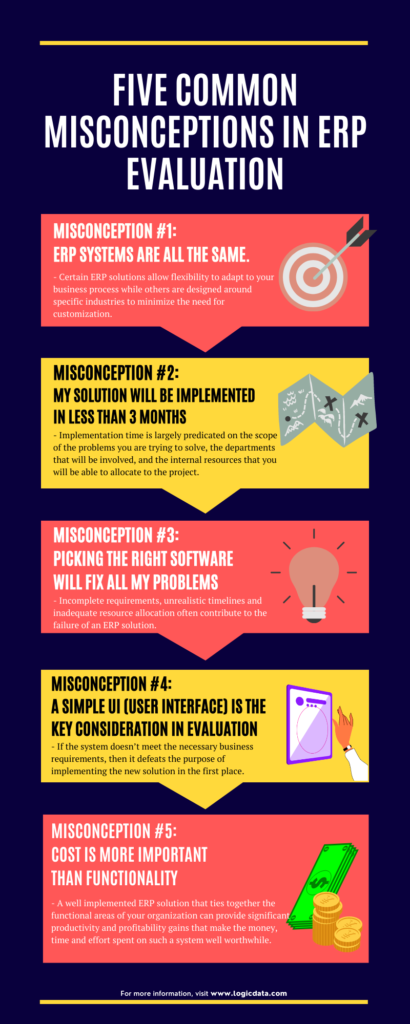

Over the past few years, my involvement in roughly 30 ERP (enterprise resource planning) evaluations from a vendor perspective have brought to light some common misconceptions worth sharing.
Although I have been in the ERP business for more than a few years and I have been involved in far more than 30 ERP evaluations, there have been some significant changes around the ERP software industry’s “go-to-market” approach that are causing some misconceptions within the target market that I support. This target demographic consists of mostly smaller, discrete manufacturers with annual revenues ranging from $20 to $100 Million that have some level of business complexity in the form of MTO (make to order) or ETO (engineer to order) processes.
If you’re not a small to mid-size manufacturer with some level of manufacturing complexity, these misconceptions may not apply.
There are hundreds of software products available that claim to fill ERP requirements. Some have very limited and point specific functionality, while others tie together all functional areas of a business to provide a complete solution. Additionally, certain ERP solutions allow flexibility to adapt to your business process while others are designed around specific industries to minimize the need for customization.
Generally, the more functionality, flexibility and industry specificity a solution has, the more business critical issues it can solve, so it is important that needs are clearly defined, and the solution is budgeted for accordingly.
If the goal is to fix a very specific problem in a specific area, likely with a point solution, then this is certainly an accurate statement. If you are attempting to implement only specific components of a broader application implementation time can also be shortened.
However, if you have complex requirements and issues that are affecting your entire organization, such as cross-functional access and visibility to data, you will likely need to implement a complete, integrated solution, which will require careful planning, process review, training and testing. The internal resources that need to be devoted to these tasks is often underestimated.
Implementation time is largely predicated on the scope of the problems you are trying to solve, the departments that will be involved and the internal resources that you will be able to allocate to the project.
While it is true that you need to choose a solution that meets your business requirements, it is even more critical that the solution is implemented successfully. There are many horror stories around ERP solution failures, not necessarily tied to product choice, but to the subsequent implementation of the software. Incomplete requirements, unrealistic timelines and inadequate resource allocation often contribute to the failure of an ERP solution (SyteLine software).
In addition to choosing an implementation partner that understands your business, make sure you are allocating the right internal resources to the project.
Having an interface that is easy for end users to navigate is certainly a benefit for adoption, however if the system doesn’t meet the necessary business requirements, then it defeats the purpose of implementing the new solution in the first place.
A better prerequisite for evaluation would be to assess the ease of use as compared to the system’s ability to solve business issues, and the capability of the solution to be customized to maximize end user efficiency.
With smaller organizations, where funding may be limited, it is often the case that only immediate problems are addressed as they arise. As the company grows and needs change, the applications put in place to fix immediate problems are no longer adequate and more applications need to be purchased, often without integration. The aggregate cost of these applications and their implementation can easily outweigh the cost of a complete solution while also not solving the common data visibility issue. Therefore, it makes sense to consider future needs during the evaluation process and ensure that the chosen solution can grow with your business.
A well implemented ERP solution that ties together the functional areas of your organization can provide significant productivity and profitability gains that make the money, time and effort spent on such a system well worthwhile. It is therefore critical that all possible due diligence be applied during the evaluation process and that the decision committee has a good understanding of current and future objectives that need to be achieved. When possible, quantify the issues to be solved in determining budget and don’t set arbitrary timelines that don’t adequately reflect that resources that will need to be allocated.
Especially in smaller companies, choosing the wrong solution can have long-term negative impact on the health of your business.
Explore the other blogs on our page for more information on ERP Evaluation and how to avoid some of the most common pitfalls in evaluating and implementing a new ERP. www.logicdata/blog/

As with cost, implementation time is also dependent on the same factors mentioned above. LogicData offers multiple implementation methodologies that can be adapted to your specific needs and resource availability. Considering a very basic implementation of just the core functionality of SyteLine, and employing a LogicData managed implementation approach, time to value can be achieved in as little as 3-4 months. A full implementation of all core SyteLine functionality utilizing a standard implementation approach, and assuming full client resource availability, can generally be completed in 6 to 8 months. To determine the best implementation methodology and timeline estimate for your specific situation, please contact us.
The cost of software and implementation will vary based on many factors such as user count, functionality requirements, deployment, implementation methodology, customization, data conversion, integration, and internal resources. However, for a basic configuration of SyteLine annual subscription pricing can begin at approximately $18,000 annually for a minimum of 10 users or a one-time cost of $20,000 plus annual maintenance for a minimum of 5 users in an on-premise deployment. A primarily self-directed implementation of such a basic configuration, although not recommended, can likely be achieved for approximately $30,000. LogicData recommends our standard “train-the-trainer” implementation approach which is estimated to start at roughly $65,000 for a basic implementation. For further information on pricing specific to your needs, please contact us.
[…] Source: https://www.logicdata.com/five-common-misconceptions-in-erp-evaluation/ […]
[…] can ensure that all major requirements will be addressed in the subsequent demonstration (check out this article for more […]
Hey there! This post could not be written any better!
Reading this post reminds me of my previous room mate!
He always kept talking about this. I will forward this post
to him. Pretty sure he will have a good read. Thanks for sharing!